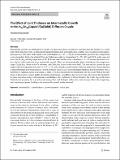| dc.contributor.author | Mouratidis, Theodore | |
| dc.date.accessioned | 2023-11-13T19:59:01Z | |
| dc.date.available | 2023-11-13T19:59:01Z | |
| dc.date.issued | 2023-11-08 | |
| dc.identifier.uri | https://hdl.handle.net/1721.1/152964 | |
| dc.description.abstract | Abstract
Intermetallic growth can simultaneously enable low-resistance electrical pathways and determine the lifetime of a solder joint. Motivating this work is a demountable linear bilateral solder joint application, enabled via a vacuum pressure impregnation process. The effect of the initial solder joint thickness
$$\delta _j = 25 - 125$$
δ
j
=
25
-
125
$$\mu $$
μ
m on intermetallic growth in this configuration is investigated for the
$$\text{In}_{52}\text{Sn}_{48}$$
In
52
Sn
48
(liquid)/Cu(solid) diffusion couple for temperatures T = 393, 413 and 433 K, in the range just above the
$$\text{In}_{52}\text{Sn}_{48}$$
In
52
Sn
48
melting temperature of 391 K. It was found that beyond a critical time
$$\sim 1-15$$
∼
1
-
15
min into the kinetic reaction, thicker solder joints had more intermetallic growth. There are two intermetallic phases identified in this temperature range:
$$\text{Cu}_{6}\text{(In,Sn)}{_5}$$
Cu
6
(In,Sn)
5
closer to the Cu substrate, and
$$\text{Cu(In,Sn)}_{2}$$
Cu(In,Sn)
2
closer to the solder bulk. The intermetallic growth fits give temporal growth exponents between
$$n = 0.25 - 0.29$$
n
=
0.25
-
0.29
, indicating that grain boundary diffusion rather than volume diffusion is the predominant growth mechanism. Growth in thicker joints is associated with higher temporal growth exponents; this is attributed to suppressed grain coarsening, as there is Cu dissolution from the intermetallic into the solder bulk in the early stages of the reaction, in more highly unsaturated environments. In addition, there is on average a decrease in the intermetallic phase activation energy with increasing joint thickness. In combination with the literature, the results suggest the linear bilateral joint geometry has a growth constraining effect, and the liquid solder phase state strongly affects the morphology and coarsening of grains, leading to the intermetallic growth trends observed. | en_US |
| dc.publisher | Springer US | en_US |
| dc.relation.isversionof | https://doi.org/10.1007/s11664-023-10764-5 | en_US |
| dc.rights | Creative Commons Attribution | en_US |
| dc.rights.uri | https://creativecommons.org/licenses/by/4.0/ | en_US |
| dc.source | Springer US | en_US |
| dc.title | The Effect of Joint Thickness on Intermetallic Growth in the In52Sn48(Liquid)/Cu(Solid) Diffusion Couple | en_US |
| dc.type | Article | en_US |
| dc.identifier.citation | Mouratidis, Theodore. 2023. "The Effect of Joint Thickness on Intermetallic Growth in the In52Sn48(Liquid)/Cu(Solid) Diffusion Couple." | |
| dc.contributor.department | Massachusetts Institute of Technology. Plasma Science and Fusion Center | |
| dc.identifier.mitlicense | PUBLISHER_CC | |
| dc.eprint.version | Final published version | en_US |
| dc.type.uri | http://purl.org/eprint/type/JournalArticle | en_US |
| eprint.status | http://purl.org/eprint/status/PeerReviewed | en_US |
| dc.date.updated | 2023-11-12T04:10:54Z | |
| dc.language.rfc3066 | en | |
| dc.rights.holder | The Author(s) | |
| dspace.embargo.terms | N | |
| dspace.date.submission | 2023-11-12T04:10:54Z | |
| mit.license | PUBLISHER_CC | |
| mit.metadata.status | Authority Work and Publication Information Needed | en_US |
